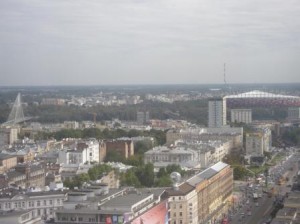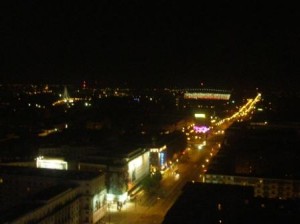Warsaw: The Phoenix City
“If only the souls buried in the ground we are stepping on could speak… ” This is how my Polish colleague starts the history of her beloved town. Warsaw is a city of grief and has witnessed far too many bitter moments along its history. It was completely flattened in the World War II and nowadays hosts former concentration camps and monuments dedicated to uprisings and unknown soldiers, eventually being seen as a huge graveyard.
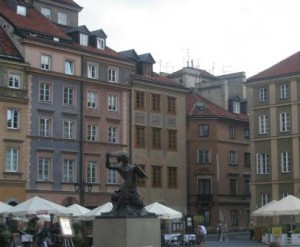 But it has not always been like this. The first thing that strikes me is all taxis bearing the logo of a mermaid. I will find the same mermaid as a statue in the Old Town Market. As I have always associated the mermaid with Denmark, I am curious to find out more. According to the local folklore Warsaw derives from the name of Warsz, a local fisherman who fell in love with a mermaid living in the Vistula River.
But it has not always been like this. The first thing that strikes me is all taxis bearing the logo of a mermaid. I will find the same mermaid as a statue in the Old Town Market. As I have always associated the mermaid with Denmark, I am curious to find out more. According to the local folklore Warsaw derives from the name of Warsz, a local fisherman who fell in love with a mermaid living in the Vistula River.
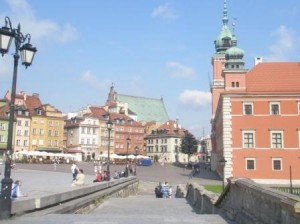 At the market’s entrance, the statue of King Sigismund III Vasa who moved the capital from Krakow to Warsaw in the 16th century stands. The Old Town has been completely reconstructed after the original 13th century architecture, with its City Walls, The Barbican and St. John’s Cathedral.
At the market’s entrance, the statue of King Sigismund III Vasa who moved the capital from Krakow to Warsaw in the 16th century stands. The Old Town has been completely reconstructed after the original 13th century architecture, with its City Walls, The Barbican and St. John’s Cathedral.
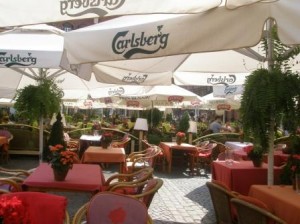 I have lunch at the fancy Fukier restaurant, decorated with red begonias. The Polish food is very tasty: beets soup with a minced meat roll and fried goat cheese with cranberry jam. Absolutely delightful!
I have lunch at the fancy Fukier restaurant, decorated with red begonias. The Polish food is very tasty: beets soup with a minced meat roll and fried goat cheese with cranberry jam. Absolutely delightful!
The journey continues and along the way I pass a former Jewish ghetto, the Tomb of the Unknown Soldier, the New Town and the Monument of the Polish Uprising (1944) mourning the 63 days when 5000 people had been killed daily according to my colleague’s story. I keep a moment of silence for the unjust fate of the Polish people. The New Town is a marvellous pedestrian area completely restored after World War II comprising attractions such as: Citadel Museum (reminding of the times when Poland was split), Traugutta Park, the historic roads (Mostowa the most picturesque street in Warsaw and Freta Street with houses from the 14th century), some churches (Casmir’s church founded in 1688 in late baroque style) and historic buildings in various styles (the neoclassic Raczynski Palace – landscape of tragic events and the rococo-facade Sapieha Palace).
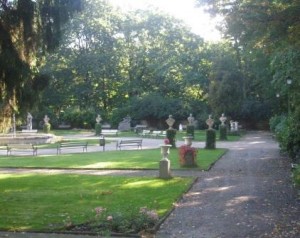 Nevertheless the best thing to do to relax is walking through Lazienki Park, considered to be one of the most charming and romantic parks in Warsaw.
Nevertheless the best thing to do to relax is walking through Lazienki Park, considered to be one of the most charming and romantic parks in Warsaw.
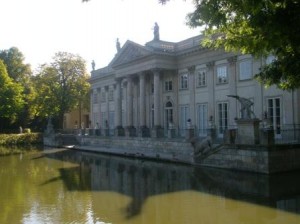 The park is huge and the main point of attraction is the neoclassic Palace on the Water that escaped the Nazis fury because of… lack of time; they did not bomb it, but set it on fire, which allowed it to be reconstructed. The whole park is full of neoclassic statues bringing to life Antiquity gods and the statues of the two famous composers: Liszt and Chopin. There is also a marvelous restaurant in the middle and several fountains and museums.
The park is huge and the main point of attraction is the neoclassic Palace on the Water that escaped the Nazis fury because of… lack of time; they did not bomb it, but set it on fire, which allowed it to be reconstructed. The whole park is full of neoclassic statues bringing to life Antiquity gods and the statues of the two famous composers: Liszt and Chopin. There is also a marvelous restaurant in the middle and several fountains and museums.
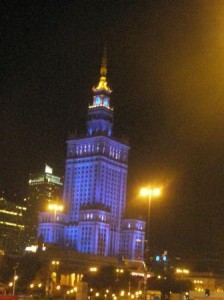 As you might have already noticed, the history and personality of the city is marked by grief but also by the tremendous power of the Polish people to overcome the past and re-build the city. However, there was still a step to surmount: the so-called socialist realism architectural style with its dull blocks. I stay in a hotel close to the Russian Tower, a gift from the Russians similar to the House of the Free Press in Bucharest now hosting the Palace of Culture and a magnificent 3D cinema famous for its good quality movies. The Polish wanted to demolish it, but finally they decided to surround it by huge skyscrapers.
As you might have already noticed, the history and personality of the city is marked by grief but also by the tremendous power of the Polish people to overcome the past and re-build the city. However, there was still a step to surmount: the so-called socialist realism architectural style with its dull blocks. I stay in a hotel close to the Russian Tower, a gift from the Russians similar to the House of the Free Press in Bucharest now hosting the Palace of Culture and a magnificent 3D cinema famous for its good quality movies. The Polish wanted to demolish it, but finally they decided to surround it by huge skyscrapers.
Actually, you would think that you are no longer on the Solidarity Avenue – Warsaw’s commercial and cultural center, but in Singapore or New York. Numerous skyscrapers and malls are being erected; cranes are all around and the new steel and glass modern buildings contrast with the communist ones. An interesting site is the former place of The Great Synagogue built at the end of the 19th century on Tłomackie Street (a Jewish neighbourhood). It was blown up following the Warsaw Ghetto Uprising in 1943 and never rebuilt. Instead, the space is now occupied by The Golden/ Blue Skyscraper, the head-quarters of many enterprises, offering offices with a 360 degree breath-taking view over the city and a chilli feeling of sitting on a cemetery.
Meanwhile, as the city proves very cosmopolitan, I enjoy some sushi in front of the Opera (very good ones and highly sought after), and leave you with striking images by day versus night of the Phoenix city that resurrected from its own ashes.

